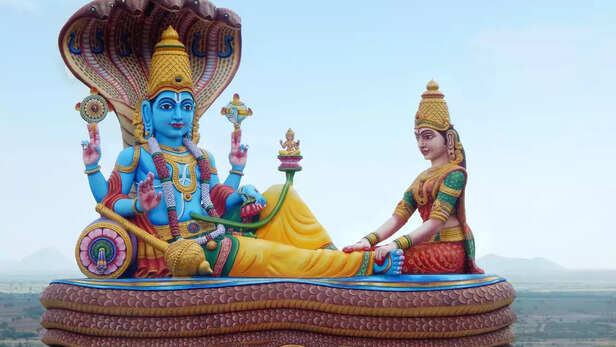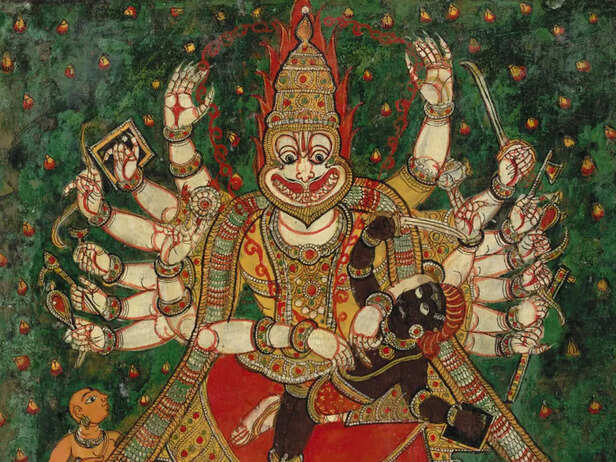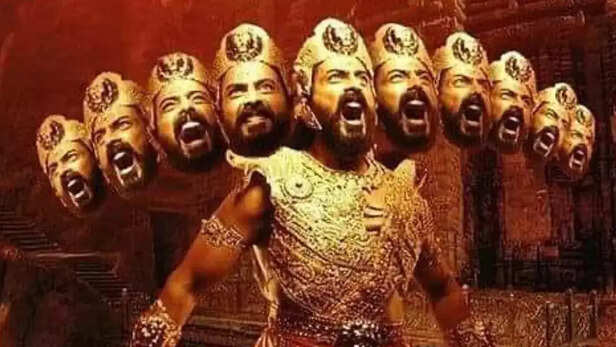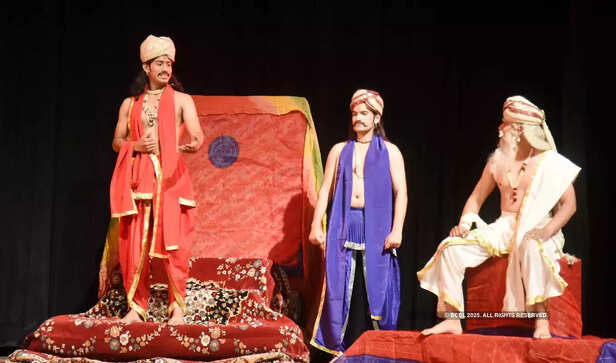Did You Know Ravana and Kumbhakarna Were Actually Vishnu’s Most Loyal Servants?
Shreya | Mar 04, 2025, 20:34 IST
Arun Govil and Arvind Trivedi.
The story of Ravana and Kumbhakarna, two of the most iconic characters from the Ramayana, is often misunderstood. While they are traditionally seen as the antagonists of the epic, there is an alternate narrative that reveals their surprising connection to Lord Vishnu. This article delves into the idea that both Ravana and Kumbhakarna were, in fact, among Vishnu's most loyal servants, following his divine will through intricate cosmic roles.
aIn Hindu mythology, Ravana and Kumbhakarna are often viewed as the villains of the Ramayana. Ravana, the powerful king of Lanka, is known for his pride and opposition to Lord Rama, while his brother Kumbhakarna is famous for his enormous size and immense strength. Both brothers are usually seen as enemies of Lord Vishnu, particularly because they stand in the way of Lord Rama's mission to defeat evil. However, there is an interesting twist in their story. According to the Bhagavata Purana, Ravana and Kumbhakarna were originally Vishnu's loyal servants, but they were cursed and reincarnated as enemies. Their story is far more complex than it seems and reveals a deeper divine plan.

Ravana and Kumbhakarna were not always demons. In their previous lives, they were Jaya and Vijaya, two gatekeepers at Vaikuntha, the heavenly abode of Lord Vishnu. Their job was to guard the gates of Vaikuntha and ensure that only those worthy of meeting Vishnu were allowed in.
One day, the Sanatha Kumaras, who were powerful and revered sages, arrived at Vaikuntha. These monks appeared as young children and, due to their age and appearance, Jaya and Vijaya refused them entry. The Sanatha Kumaras, deeply offended by this act of arrogance, cursed the gatekeepers. They declared that Jaya and Vijaya would be cast out of Vaikuntha and sent to Earth.
Upon hearing about this curse, Lord Vishnu, though understanding of the sages’ anger, accepted the punishment. However, Vishnu offered Jaya and Vijaya two options. First, they could be born seven times as ordinary mortals and devotees of Vishnu, or second, they could be born three times as powerful beings but as enemies of Vishnu. Eager to return to their place in Vaikuntha quickly, Jaya and Vijaya chose the second option - being born as strong enemies of Vishnu for three lifetimes.

The first birth of Jaya and Vijaya occurred in the Satya Yuga, the age of truth. They were born as two demons, Hiranyaksha and Hiranyakashipu. Both brothers were incredibly powerful and posed a threat to the balance of the universe. Hiranyaksha, the older brother, challenged Lord Vishnu and was eventually slain by Vishnu’s Varaha (boar) avatar. Hiranyakashipu, the younger brother, became even more arrogant and powerful, and he was eventually killed by Vishnu’s Narasimha (half-man, half-lion) avatar.

The second birth of Jaya and Vijaya took place in the Treta Yuga, the age of the Ramayana. In this incarnation, they were born as Ravana and Kumbhakarna. Ravana became the mighty king of Lanka, and Kumbhakarna, his brother, was known for his massive size and incredible strength. In this form, they were destined to oppose Lord Vishnu, who incarnated as Lord Rama.
Ravana, with his immense power and arrogance, abducted Sita, the wife of Lord Rama, which led to the famous war in the Ramayana. Ravana believed that he could defeat Rama and his army, but in the end, Ravana was slain by Lord Rama in the battle. Kumbhakarna, despite his loyalty to his brother, was also defeated by Rama. Though they were enemies of Vishnu in this birth, their actions played an important role in fulfilling Vishnu’s cosmic plan.
Ravana and Kumbhakarna, though seeming to oppose Vishnu, were not evil in the true sense. They were following their roles in the divine drama, or Lila, set by Vishnu to restore cosmic balance. Their defeat at the hands of Lord Rama was necessary for the victory of good over evil and for the fulfillment of Vishnu’s divine purpose.

The third and final birth of Jaya and Vijaya took place in the Dvapara Yuga, the age of Lord Krishna. In this birth, they were born as Dantavakra and Shishupala, two powerful enemies of Lord Krishna. Just like the previous births, these two characters caused trouble for Krishna, and ultimately, they were both killed by him. This marked the end of their curse, and they were finally released from their cycle of reincarnation.

The story of Ravana and Kumbhakarna is a perfect example of how divine will operates in Hindu mythology. Though they were born as enemies of Vishnu, their roles were essential to the divine order. The curse they received was not just punishment; it was part of a larger cosmic plan. Vishnu’s avatars, from Varaha to Narasimha to Rama and Krishna, all played vital roles in restoring balance to the universe. Without Ravana and Kumbhakarna's opposition, these avatars would not have had the opportunity to fulfill their divine missions.
In true sense, Ravana and Kumbhakarna were not enemies of Vishnu, but loyal servants who, through their arrogance and pride, ended up in the roles they played. Their actions, though seemingly evil, were ultimately part of the divine plan that ensured the triumph of good over evil. This highlights a key teaching in Hindu philosophy: that all events, even those that seem negative or destructive, are part of the larger cosmic order and play a role in maintaining balance.
The story of Ravana and Kumbhakarna teaches us that nothing in the universe happens without purpose. These two mighty figures, though seen as antagonists in the Ramayana, were actually deeply connected to Lord Vishnu’s divine plan. They were once his loyal servants, and their reincarnations as enemies were part of a larger cosmic cycle that helped restore balance to the world.
By understanding their true origins and roles, we can see that their actions, though destructive in appearance, were part of the divine drama that leads to the ultimate victory of good. The story of Ravana and Kumbhakarna reminds us that in the grand scheme of the universe, even the darkest moments serve a higher purpose.
The Origin of Ravana and Kumbhakarna: Jaya and Vijaya

Lakshmi Narayan
Ravana and Kumbhakarna were not always demons. In their previous lives, they were Jaya and Vijaya, two gatekeepers at Vaikuntha, the heavenly abode of Lord Vishnu. Their job was to guard the gates of Vaikuntha and ensure that only those worthy of meeting Vishnu were allowed in.
One day, the Sanatha Kumaras, who were powerful and revered sages, arrived at Vaikuntha. These monks appeared as young children and, due to their age and appearance, Jaya and Vijaya refused them entry. The Sanatha Kumaras, deeply offended by this act of arrogance, cursed the gatekeepers. They declared that Jaya and Vijaya would be cast out of Vaikuntha and sent to Earth.
Upon hearing about this curse, Lord Vishnu, though understanding of the sages’ anger, accepted the punishment. However, Vishnu offered Jaya and Vijaya two options. First, they could be born seven times as ordinary mortals and devotees of Vishnu, or second, they could be born three times as powerful beings but as enemies of Vishnu. Eager to return to their place in Vaikuntha quickly, Jaya and Vijaya chose the second option - being born as strong enemies of Vishnu for three lifetimes.
The First Birth: Hiranyaksha and Hiranyakashipu

Narasimha and Hiranyakashipu.
The first birth of Jaya and Vijaya occurred in the Satya Yuga, the age of truth. They were born as two demons, Hiranyaksha and Hiranyakashipu. Both brothers were incredibly powerful and posed a threat to the balance of the universe. Hiranyaksha, the older brother, challenged Lord Vishnu and was eventually slain by Vishnu’s Varaha (boar) avatar. Hiranyakashipu, the younger brother, became even more arrogant and powerful, and he was eventually killed by Vishnu’s Narasimha (half-man, half-lion) avatar.
The Second Birth: Ravana and Kumbhakarna

Karthik Jayaram as Ravana.
The second birth of Jaya and Vijaya took place in the Treta Yuga, the age of the Ramayana. In this incarnation, they were born as Ravana and Kumbhakarna. Ravana became the mighty king of Lanka, and Kumbhakarna, his brother, was known for his massive size and incredible strength. In this form, they were destined to oppose Lord Vishnu, who incarnated as Lord Rama.
Ravana, with his immense power and arrogance, abducted Sita, the wife of Lord Rama, which led to the famous war in the Ramayana. Ravana believed that he could defeat Rama and his army, but in the end, Ravana was slain by Lord Rama in the battle. Kumbhakarna, despite his loyalty to his brother, was also defeated by Rama. Though they were enemies of Vishnu in this birth, their actions played an important role in fulfilling Vishnu’s cosmic plan.
Ravana and Kumbhakarna, though seeming to oppose Vishnu, were not evil in the true sense. They were following their roles in the divine drama, or Lila, set by Vishnu to restore cosmic balance. Their defeat at the hands of Lord Rama was necessary for the victory of good over evil and for the fulfillment of Vishnu’s divine purpose.
The Third Birth: Dantavakra and Shishupala

Play on Mahabharata
The third and final birth of Jaya and Vijaya took place in the Dvapara Yuga, the age of Lord Krishna. In this birth, they were born as Dantavakra and Shishupala, two powerful enemies of Lord Krishna. Just like the previous births, these two characters caused trouble for Krishna, and ultimately, they were both killed by him. This marked the end of their curse, and they were finally released from their cycle of reincarnation.
The Divine Plan Behind Their Curse

Rama and Ravana.
The story of Ravana and Kumbhakarna is a perfect example of how divine will operates in Hindu mythology. Though they were born as enemies of Vishnu, their roles were essential to the divine order. The curse they received was not just punishment; it was part of a larger cosmic plan. Vishnu’s avatars, from Varaha to Narasimha to Rama and Krishna, all played vital roles in restoring balance to the universe. Without Ravana and Kumbhakarna's opposition, these avatars would not have had the opportunity to fulfill their divine missions.
In true sense, Ravana and Kumbhakarna were not enemies of Vishnu, but loyal servants who, through their arrogance and pride, ended up in the roles they played. Their actions, though seemingly evil, were ultimately part of the divine plan that ensured the triumph of good over evil. This highlights a key teaching in Hindu philosophy: that all events, even those that seem negative or destructive, are part of the larger cosmic order and play a role in maintaining balance.
The story of Ravana and Kumbhakarna teaches us that nothing in the universe happens without purpose. These two mighty figures, though seen as antagonists in the Ramayana, were actually deeply connected to Lord Vishnu’s divine plan. They were once his loyal servants, and their reincarnations as enemies were part of a larger cosmic cycle that helped restore balance to the world.
By understanding their true origins and roles, we can see that their actions, though destructive in appearance, were part of the divine drama that leads to the ultimate victory of good. The story of Ravana and Kumbhakarna reminds us that in the grand scheme of the universe, even the darkest moments serve a higher purpose.
